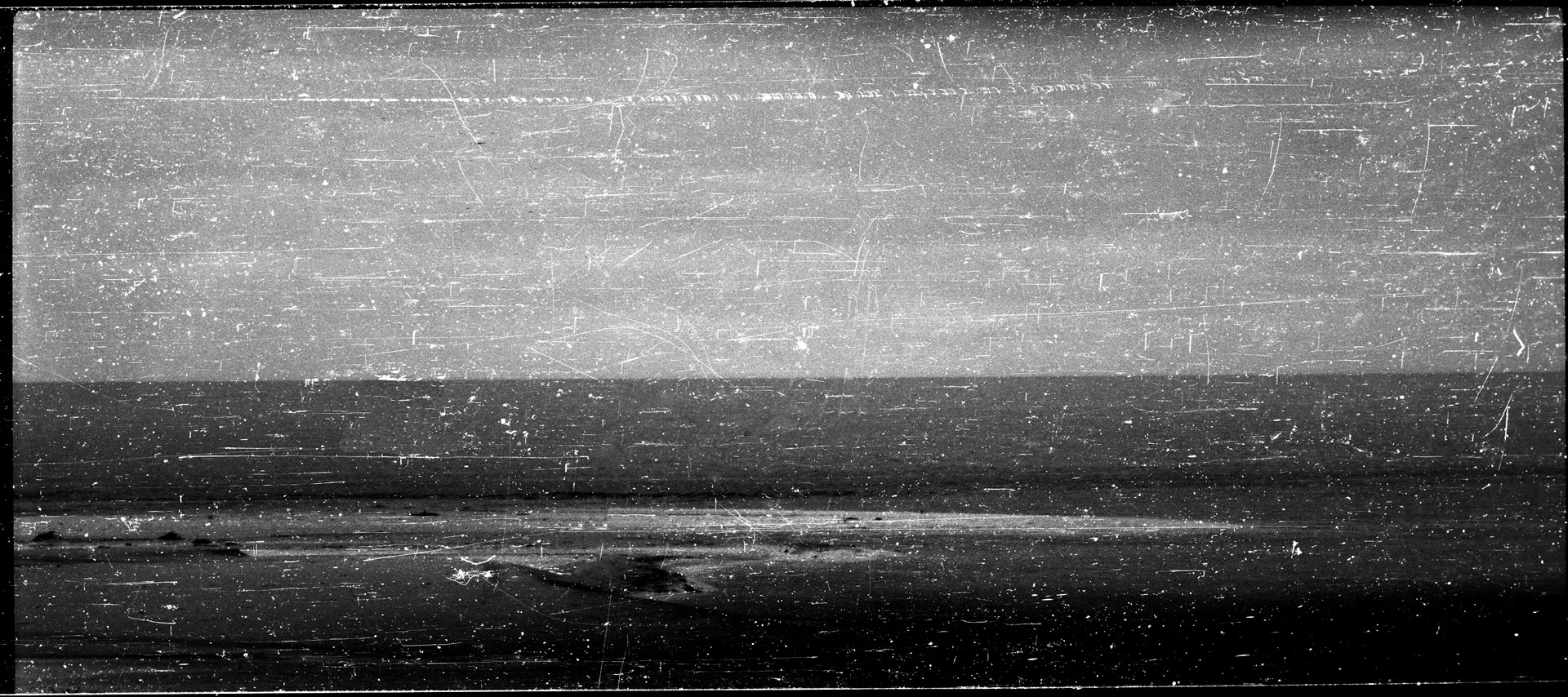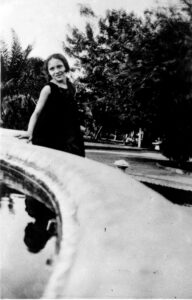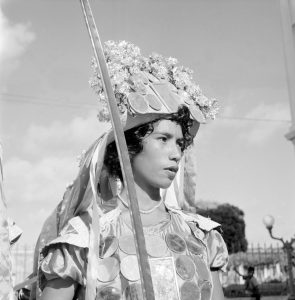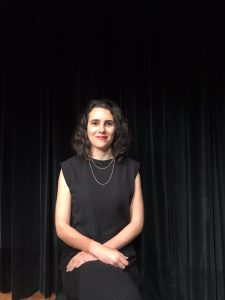Robert Moraes, Eliane. The Darkness in Darkness. IMS Clarice Lispector, 2024. Disponível em: https://site.claricelispector.ims.com.br/en/2024/05/16/the-darkness-in-darkness/. Acesso em: 05 January 2026.
Darkness is a hollow word and one never really knows what fits inside Its dimensions are so undetermined that perhaps it could even be said that everything fits and nothing fits in it, since, being an immense storehouse of paradoxes, the ambiguous quality of immeasurable is immediately added to the primordial void that characterizes it. These attributes, thus agreed, gain particular density when prepared by the wrought of the author of The Apple in the Dark.
It is worth noting the passage in this novel in which the protagonist declares himself relieved to have “escaped unscathed the hollow darkness,” since this occurs when he realizes the absurd plot that the “perfect darkness” precipitates with its endless nonsense: “He was feeling elementarily protected by the darkness, though it was the darkness itself that scared him the most.” It happens that, most of the time, Martim circulates through the troubled realm of chaos and, if it is definitely imposed on him as a threat, it is also from this “depth of centuries of fear and helplessness” that a new and unexpected force arises in him: “[a] man in the dark was a creator” (LISPECTOR, 2023).
The ability to inhabit at the same time emptiness and the immeasurable describes one of the most common dispositions among Clarice’s characters, and it is often expressed by intense harmony with the realm of darkness. It is not surprising, therefore, that this word repeated countless times in the writer’s fiction needs some elucidation, however minimal it is, along its equally countless pages. Actually, it concerns another paradox, since the more the signifier darkness is present in her literature, the less it is unraveled, defined, or clarified. In short: the storytelling universe of Clarice Lispector does not admit a possible explanation for darkness or a thought that can account for whatever it might want to represent.
Hence the idea of clarifying – dear to a philosophy that declares itself enlightened and unfolds in the dialectic of clarification – becomes a kind of opposite to this sombre realm that resists any and all clarity. It should be recalled that, already since its beginnings in the eighteenth century, European Enlightenment philosophers took as a basis for their trade the definition attributed to Denis Diderot for the entry philosophe in the great Encyclopedia, which thus presents the thinker of the so-called “Siècle des Lumières:” “il marche la nuit, mais il est précédé d’un flambeau” (DIDEROT/ENCYCLOPÉDIE, Vol. XII, p. 510). Now, this night always illuminated by the flame that precedes the philosopher, in which obscurity itself bows to the tools of reason, provides an antithesis to Clarice’s darkness, which rather assumes a state of knowledge, if one may say so, of another kind and of another magnitude. Thus, if her characters also tend, in the example of the encyclopedist thinker, to move in the midst of the chaos of the night, for them it never concerns illuminating it, but rather being illuminated by it.
There are several texts by the writer that develop this conception, which is almost always introduced in a frankly dreamlike tone. Beginning with the dream recounted in “The Jelly as Alive as a Placenta,” which itself took place during a “pitch-black night,” whose desperate protagonist decides to kill herself by jumping from a “dark terrace, my lips moist with a living thing,” and suddenly encounters the unknown: “My legs were already over the edge of the balcony when I saw the eyes of the darkness. Not ‘eyes in the darkness,’ but the eyes of the darkness. The darkness was peering at me with two large, wide-set eyes. The darkness, therefore, was also alive. Where would I find death?” (LISPECTOR, 2022b)
Darkness seems to triumph over death, thus boasting a life of its own that is only on a par with infinity.
In the same gallery of types that are seen through the dark, it is worth evoking the unusual fragment titled “The Most Dangerous Night,” in which a pleading voice asks to be believed, by making use of coded expressions that also suggest the intention of a suicide. In saying that “a fateful ritual was taking place” there, at a time when she was trying to explain “what the others can’t understand,” she embarks on a sinuous narrative:
[…] the drawing room lay in darkness – but the music drew me into the center of the room – something in there was awake – the room grew still darker within the darkness – I was there in the gloom – I felt that, despite the darkness, the room was still light – I wrapped myself in fear – just as I once wrapped myself in you – what did I find? – nothing, only that the dark room was filling up with a brightness illuminating nothing – and that I stood trembling in the center of that difficult light – believe me, please, however hard it is to explain. (LISPECTOR, 2022b)
Less exasperating but equally dense, the scene is even repeated in Near to the Wild Heart, when Joana curls up “[i]n her silent bed, floating in the darkness […] as if in the lost womb and forgets. Everything is vague, light and silent.” For her, “[s]leeping was an adventure every night, falling from the easy clarity in which she lived into the same mystery, dark and cool, crossing darkness. Dying and being reborn.” Therefore, just before shrinking “back inside herself, full of fear, of her unconfessed dread of the rainless nights of old, in the darkness wide awake” (LISPECTOR, 2012, p. 58, 91, 125), she abandons herself to strange daydreams that, once again, suggest a form of light – it would be better to say lucidity – which is only possible to distinguish in the thickest darkness:
A certain degree of blindness is necessary in order to see certain things. This is perhaps the mark of an artist. Any man might know more than him and safely reason, according to the truth. But those things in particular cannot be seen with the light on. In the darkness they become phosphorescent. (LISPECTOR, 2012, p. 110).
Beings of chaos, suicides, madmen, artists, and the like often abandon themselves to the “phosphorescence” of formless and endless nights when they share a singular grammar of the gaze under an intense light that illuminates nothing. Aware of this, the author of The Foreign Legion completely avoids any clarification about darkness, always preferring, when approaching it, the resource of allusion to that of revelation. After all, according to Clarice, there is nothing to be revealed in a place completely deprived of light.
It would be the case, then, of asking “where does the light go when it hides?”1 as Maria Filomena Molder does with great propriety. In her sharp essay on the subject, the Portuguese thinker observes that it does not concern a question about invisibility, since hiding always implies agonic – that is, dramatic – representative forms that reiterate, each in their own way, the recurring clash between day and night. For example, she mentions a powerful nocturnal figure presented in the Iliad as a “tamer of gods and men” who, by contemplating “the entire collection of all hiding places, from the extreme to the most intimate,” also introduces herself as a darkness that “gazes at us.” 2
Molder evokes the motif in examples that dialogue in depth with Clarice’s conceptions. Among the ancients, references to Greek mythology gain prominence, in particular to the gods who invented a specific name for a very special kind of diurnal beings called “ephemerals,” who were responsible for watching and guarding the night, “even feeling their strength yielding as soon as the light disappears.” 3 The question has repercussions in the sphere of modern authors, among whom the commentator chooses the contemporary Portuguese poet Manuel Gusmão, thus quoting the following notable verses from his book Teatros do tempo (Theaters of Time):
It thus concerns having sat down looking for the gaze
the gaze of the night that gazes at him. He stares at it for a long time –
……………………………………………. ………………………..
This would be the light motif: the switch:
That which switches and closes is that which opens up and turns on.
You say: someone pressed the switch; time
switched and the night gazes at the body of the man
who neither hopes nor despairs; he is. (MOLDER, 2017, p. 13-15) 4
Now, this night that gazes – or, to translate into Lispector’s terms: the great eyes of the darkness – undoubtedly demarcates the limits of human knowledge: as the poet says, he who receives this gaze, who neither hopes nor despairs, simply is. Just like a being that seems not to have any reflexive folds, it is pure body and pure presence, inhabiting an absolute present, in the example of an immobile and living statue. It is not surprising that this image, which is likewise paradoxical, also appears transfigured in Clarice’s short story “The Fifth Story,” whose narrator uses an “elixir for drawn-out death” to exterminate the disgusting insects that invade her home and about which she incessantly complains. To account for the effect of the poison, while “darkness was sleeping” she crosses “the silence of the apartment” and encounters the inanimate bodies of cockroaches that resemble the living dead:
And in the darkness of dawn, a purplish glow that distances everything, I discern at my feet shadows and white forms: dozens of statues scattered, rigid. The cockroaches that have hardened from the inside out. Some, belly up. Others, in the middle of a gesture never to be completed. In the mouths of some a bit of the white food. I am the first witness of daybreak in Pompeii. I know how this last night went, I know of the orgy in the dark. Inside some of them the plaster will have hardened as slowly as during some vital process, and they, with increasingly arduous movements, will have greedily intensified the night’s joys, trying to escape their own insides. Until they turn to stone, in innocent shock, and with such, such a look of wounded reproach. (LISPECTOR, 2022a, p. 310-311).
The cockroaches annihilated in the dead of night also gaze at their killer with fright and terror. A strange life animates even the most mummified, while “occasional antenna of a dead cockroach quivers drily in the breeze,” thus sanctioning the accusation against the “[m]eticulous, ardent” executioner who returns their frozen gaze (LISPECTOR, 2022a, p. 310-311). It is also with fright and terror, it is worth recalling, that the four masked youth in the story “Mystery in São Cristóvão” are petrified for an instant when invading an enchanted garden in the early hours of Rio de Janeiro, as if swallowed by the “possibilities afoot on a May evening:” “everything in the dark was mute approach,” the astonished narrator observes, only to add: “[h]aving fallen into the ambush, they looked at each other in terror: the nature of things had been cast into relief and the four figures peered at each other with outstretched wings.” (LISPECTOR, 2022a, p. 211)
Among the several affinities that are recognized in all these passages, the focus built around not knowing draws attention: strictly speaking, the cockroaches and their executioner, or the youth surprised by the risky unforeseen occurrences late at night, reveal the same original and ancestral mystery guarded by the haughty figure of the tamer from the Iliad who lends her eyes to the night. According to these fables, darkness would really be a state of suspension of knowledge and perhaps it is for this reason that, in the figurative sense, most current dictionaries associate such a signifier with the “absence of knowledge.”
Everything would tend to confirm that there is actually nothing to be revealed in a place deprived of light, if it were not for the exception made by Clarice for those beings who, having “a certain degree of blindness,” can “see certain things” in complete darkness. It is a significant exception that refers to two groups of very distinct creatures, which are in fact the true inhabitants of the dark: on the one hand, the blind prophets, such as Tiresias, Bartimaeus, and many others presented in theologies and mythologies; on the other, the animals that live in the depths of the sea, such as the unusual pelagic specimens.
Needless to say, the blind man is a recurring figure in Clarice’s literature and, although he is not specifically identified as a prophet, seer, or oracle, he most often shares with them some gift of divination. Even a nearsighted child, like the boy in the story “Evolution of a Myopia,” makes one understand that a simple visual impairment can give access to the paths of clairvoyance, since the less he sees, the more and more he understands: “It was only as if he’d taken off his glasses, and myopia itself is what made him see.” After all, “whenever his confusion grew and he could barely see, he’d take off his glasses under the pretext of wiping them and, without his glasses, fix his interlocutor with the reverberating stare of a blind man” (LISPECTOR, 2022a, p. 308).
An exemplary case in this sense is given by the character from the short story “Love,” who “was chewing gum in the dark” when he is caught by Ana. Just like a prosaic fortune teller, “[w]ithout suffering, eyes open,” his presence is enough for the girl to come to see precisely that which it is not possible for her to see, to discover what was covered by prohibitions: in the moment that he is caught, “her heart beat violently, at intervals. Leaning forward, she stared intently at the blind man, the way we stare at things that don’t see us.” (LISPECTOR, 2022a, p. 117-118) In fact, the state of blindness returns with great frequency in the pages of Clarice, either to refer to the “blindness of the dark” itself, or to highlight the “milky and translucent darkness,” as can be read in The Chandelier, thus always reinforcing the existence of a luminous power in the dark that only beings deprived of vision manage to see. In this sense, the author’s fabled stories about the “animals of the dark” gain particular prominence (LISPECTOR, 2018, p. 6, 119).
“What animals?” asks the protagonist of The Apple in the Dark, only to answer with “the obstinacy of pleasure:” “the animals of which the darkness is made.” (LISPECTOR, 2023). If these at times gain somewhat bizarre approximations – “[t]he trinkets were gleaming in a brightness of their own like deep-sea animals” (LISPECTOR, 2023) –, at other times they are simply associated with the animals that emerge “one by one from their lairs, protected by the gentle animal possibility of the night” (LISPECTOR, 2023). Their most striking appearance, however, is made in The Besieged City, when a character recalls that “marine beings, when not affixed to the sea floor, adapt to a drifting or pelagic life.” The notation is part of the studies of the strange Perseus, on a date recorded as “the afternoon of May 15, 192…” Standing by the open window, “[b]lind and glorious,” he repeats several times, with “hollow luminosity:” “Pelagic animals reproduce with profusion.” And he reiterates some more, closely followed by the narrator who continues recording: “‘Marine animals and plants with profusion,’ he said without a push but without brakes because this was his degree of light. It didn’t matter that in the light he was as blind as in the dark. The difference is that he was in the light. ‘Drifting,’ he said.” (LISPECTOR, 2019).
This mention of the pelagic ecosystem is still curious – pelagos in Latin means “open sea” – since it is an oceanic region inhabited by living beings that, although close to the seabed, do not depend on it. It concerns a hybrid and indeterminate zone, located in an intermediary that starts below the space influenced by the tides to extend until the high seas, at depths that vary from a few dozen meters to around six thousand meters. It should be observed that, if the parts close to the surface receive sunlight, the deeper ones are home to a large number of species that are adapted to darkness, being that a few of their inhabitants answer to the imposing name of deep-sea fish.
Clarice’s reference to the pelagic zone perhaps constitutes the closest note to what her definition of darkness would be, because if there is some element that she links to such a state, it is certainly water. It concerns, most of the time, a liquid darkness, whose water almost always comes from the sea. This is what Clarice’s texts repeat exhaustively, by making use of the most diverse perspectives to propose such an affinity, beginning with the frequent allusion to characters who were “floating in the half-light” or who were “plunging into the darkness.” Also in The Chandelier, “the darkness was sprinkled by wet and abrupt noises,” as well as “stretching out uniformly and when the wind blew the bushes seemed to move in a sea” (LISPECTOR, 2018, p. 19, 38). The nocturnal images related to water unfold in many directions, which pass not only through the heart, described as an “an organ bathed in the darkness of pain” (LISPECTOR, 2022a, p. 495), but even to a room that, at night, “was floating before eyes that had just arrived from the darkness” (LISPECTOR, 2019).
It is important to highlight here that, although unlikely, the approximation between blind prophets and pelagic animals may be surprising due to its pertinence, which is justified by a greater affinity: as beings of the darkness, both have in common the knowledge of the depths: the former, due to perceiving what is beyond the visible; the latter, due to discerning nothing beyond the very obscurity that surrounds them. Indeed, both could be defined in the same terms of which the narrator of the short story “The Smallest Woman in the World” makes use, when describing the inaccessible pygmy considered “[d]ark as a monkey” by those who do not see her humanity: “having no other resources, she was reduced to profundity” (LISPECTOR, 2022a, p. 165, 171).
In all these cases, such a reduction completely avoids clarity and prevents any identification with the naked eye. Actually, in the example of what happens with the seabed, this diffuse and impenetrable depth is never revealed to those who discern its realms from the outside, since knowing it requires complete immersion in the opacity of the unknown. This is confirmed in the passage from the text “The Servant” that describes Eremita, another character who is definitely associated with the deepest recesses of existence: “no one would find a thing if they descended into her depths—except depth itself, as in the dark you find the dark” (LISPECTOR, 2022a, p. 391).
This perhaps outlines the most conclusive meaning from the author of Discovering the World about the unfathomable darkness, which discreetly reappears in a few other writings, always enveloped by a certain hermetism, as is the case in the passages from The Apple in the Dark: “darkness seeks darkness,” or “the light of the dog’s eyes in the darkness of the dog,” or “[i]f a man were to touch the darkness a single time, offering it in exchange darkness itself…” (LISPECTOR, 2023), or even in the writer’s brief and decisive note dated 1968: “And the darkness is very dark” (LISPECTOR, 2022b). Darkness is a closed labyrinth, with no entrance or exit: it is not surprising, therefore, that the signifier hollow fits it so well, for projecting a void in the shape of a palindrome that has no beginning or end. 5
According to Clarice Lispector, darkness has no folds, is not reflected in any mirror, and does not even recognize the existence of any otherness, since it is absolute otherness. Within it there is only darkness, actually, a hollowness from which all creation can spring.
- The original quote in Portuguese reads: “para onde vai a luz quando se esconde.”[↩]
- The original quotes in Portuguese read: “domadora de deuses e de homens;” “a reunião inteira de todos os esconderijos, dos extremos aos íntimos;” “olha para nós.”[↩]
- The original quote in Portuguese reads: “mesmo sentindo as forças a ceder logo que a luz se esconde.”[↩]
- The original quote in Portuguese reads:
“Trata-se pois de se ter sentado procurando o olhar
o olhar da noite que o olha. Longamente o fita –
……………………………………………. ………………………..
Seria este o motivo light: o interruptor:
O que interrompe e fecha é o que abre e acende.
Dizes: alguém carregou no interruptor; o tempo
interrompeu-se e a noite olha o corpo do homem
que não espera nem desespera; está.”[↩] - I would like to thank Yudith Rosenbaum for this suggestion and others.[↩]







